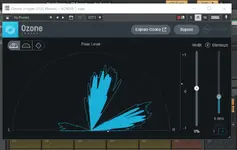S
Svemir
Member
Hi guys/gals,
I'm not such a pro at mixing and I'm still learning, despite this I have recorded and mixed a few songs at home which sounds pretty ok to me.
I'm using Cakewalk by Bandlab, I'm now in the phase where I'm trying to understand a few things like Mix balance, stereo width and phase issues.
I downloaded Izotope Ozone Imager (freeware version) and upload it on my Master bus, I was wondering if any of you is using it and would give me some tips.
There are some things that are not quite clear to me.
So I have read and followed pretty much the LCR technique, recommended by lot of mixing engineers, so in my mix (instrumental song), I have drums, bass and lots of guitars with clean and distorted parts.
So where I have only 2 guitars I panned them 100% right and left, when 3 guitars I put 2 on the sides and one in the mid. Bass and drums in the center.
I used a reference track and also there I can hear the guitars 100% or so panned L/R.
I tried to look at the stereo ozone imager graph on the master bus but it's not clear to me what should it looks like, how it is suppose to look?
I understand that the -1/0/1 bar on the right should be between 0 and 1, if it goes to -1 it's out of phase.
If it's out of phase, what should I do to the mix? pan the guitars I put 100% left and right more in the middle? like 60/50 % pan?
If so, that wouldn't follow anymore the LCR technique correct? I want my guitars to be wide.
Out of phase means the instrument is too much panned left and right and so should be panned more in the mid? Am I wrong?
In my mix in the first (clean) part of the song it goes under 0 on the right bar, so it seems out of phase, what should be done to avoid this? again not pan the guitars 100% R/L?
Also the waves I see in the imager left and right should not be larger or the same as the one in the middle? or is it ok?
WHat if one wave on the left end is longer that the one on the right? is it bad?
Could someone please clarify these points?
Here's my mix if someone would like to have a listen.
https://drive.google.com/file/d/1oLGf45PdSCaTDvxdgJU7Fm2DdYNpHXeG/view?usp=sharing
Thanks

I'm not such a pro at mixing and I'm still learning, despite this I have recorded and mixed a few songs at home which sounds pretty ok to me.
I'm using Cakewalk by Bandlab, I'm now in the phase where I'm trying to understand a few things like Mix balance, stereo width and phase issues.
I downloaded Izotope Ozone Imager (freeware version) and upload it on my Master bus, I was wondering if any of you is using it and would give me some tips.
There are some things that are not quite clear to me.
So I have read and followed pretty much the LCR technique, recommended by lot of mixing engineers, so in my mix (instrumental song), I have drums, bass and lots of guitars with clean and distorted parts.
So where I have only 2 guitars I panned them 100% right and left, when 3 guitars I put 2 on the sides and one in the mid. Bass and drums in the center.
I used a reference track and also there I can hear the guitars 100% or so panned L/R.
I tried to look at the stereo ozone imager graph on the master bus but it's not clear to me what should it looks like, how it is suppose to look?
I understand that the -1/0/1 bar on the right should be between 0 and 1, if it goes to -1 it's out of phase.
If it's out of phase, what should I do to the mix? pan the guitars I put 100% left and right more in the middle? like 60/50 % pan?
If so, that wouldn't follow anymore the LCR technique correct? I want my guitars to be wide.
Out of phase means the instrument is too much panned left and right and so should be panned more in the mid? Am I wrong?
In my mix in the first (clean) part of the song it goes under 0 on the right bar, so it seems out of phase, what should be done to avoid this? again not pan the guitars 100% R/L?
Also the waves I see in the imager left and right should not be larger or the same as the one in the middle? or is it ok?
WHat if one wave on the left end is longer that the one on the right? is it bad?
Could someone please clarify these points?
Here's my mix if someone would like to have a listen.
https://drive.google.com/file/d/1oLGf45PdSCaTDvxdgJU7Fm2DdYNpHXeG/view?usp=sharing
Thanks
Attachments
Last edited:

